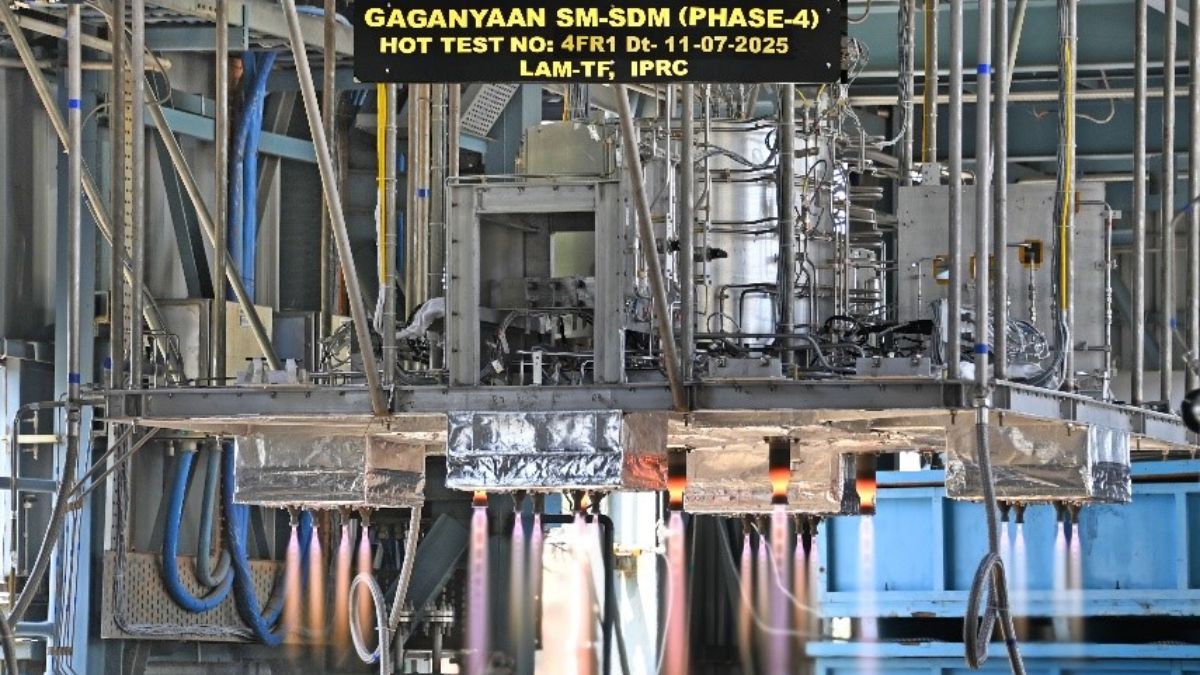Behind the scenes of Gaganyaan: Which spacecraft part powers India's human space mission?
 From the hot bed test of the Service Module (SM) of Gaganyaan | ISRO
From the hot bed test of the Service Module (SM) of Gaganyaan | ISRO
ISRO has achieved a major breakthrough in its human spaceflight programme, Gaganyaan, by successfully completing the development and testing of the Service Module Propulsion System (SMPS). On July 11, 2025, ISRO carried out a full-duration hot test of the SMPS, lasting 350 seconds, to confirm its performance in off-nominal conditions—situations where the spacecraft might face unexpected challenges. The test results matched pre-test expectations, confirming that the SMPS is ready for flight. This milestone brings India one step closer to launching its first manned mission to space.
The Gaganyaan spacecraft consists of two main parts—the Crew Module and the Service Module. The crew module is the section where astronauts will stay.
It is built to keep them safe during launch, orbit, and re-entry. It includes life support systems, seats, and heat shields. The service module, on the other hand, plays a supporting role. It houses the propulsion system, provides electrical power, and manages thermal control. It also carries the Service Module Propulsion System (SMPS), which enables the spacecraft to move in space and complete its journey safely.
"The SMPS is like the engine of the Gaganyaan spacecraft. It helps in key tasks such as orbit circularisation (adjusting the orbit once the spacecraft reaches space), on-orbit control (keeping the spacecraft stable while it orbits Earth), and deboost manoeuvres (slowing the spacecraft to bring it back to Earth). It also plays a critical role in ascent phase aborts, where it can help pull the crew module away from the rocket if a problem occurs during launch," explained space analyst Girish Linganna.
The propulsion system includes Liquid Apogee Motors (LAMs) for the main thrust and Reaction Control System (RCS) thrusters for small, precise adjustments to the spacecraft's direction and position.
To test this system thoroughly, ISRO built a special ground model called the System Demonstration Model (SDM). This model copied the real Service Module's fuel system, including propellant tanks, pipes, valves, and a helium pressurisation system. Helium is used to maintain the required pressure in the fuel lines, ensuring a steady and controlled flow of fuel to the engines during all phases of the mission.
The SDM also included all the flight-ready thrusters and control components. It underwent 25 tests under both normal and emergency conditions, with a total test time of 14,331 seconds.
These tests made sure the system could perform reliably under various mission situations. The SMPS was designed and developed by the Liquid Propulsion Systems Centre (LPSC), and the testing took place at the ISRO Propulsion Complex (IPRC) in Mahendragiri.
But what is the difference between the crew module and the service module? "While the Crew Module is designed to carry and protect the astronauts, the Service Module provides the necessary systems that support the mission—like propulsion, fuel storage, power supply, and thermal management. However, during re-entry into Earth's atmosphere, the Service Module is jettisoned, or separated, from the spacecraft. This separation happens before the crew module begins its return to Earth.
Once detached, the Service Module does not come back—it burns up in the Earth's atmosphere due to the extreme heat of re-entry. This reduces the spacecraft's weight, avoids space debris, and ensures a safer descent for the astronauts in the crew module,' added Linganna.
The successful development and testing of the SMPS is a crucial achievement for the safety and success of Gaganyaan. It shows that ISRO now has a reliable propulsion system that can handle different mission conditions, including emergencies.
Sci/Tech